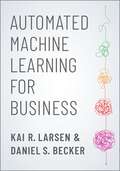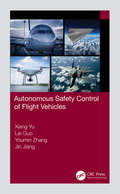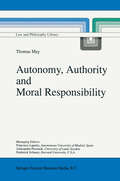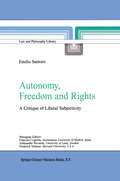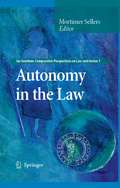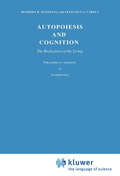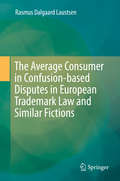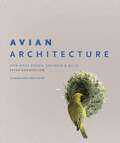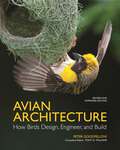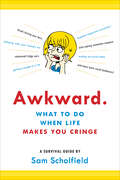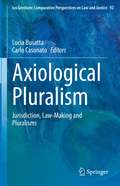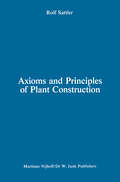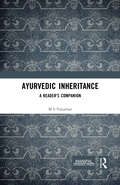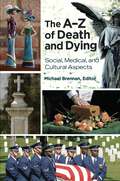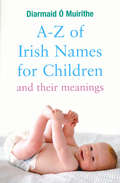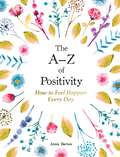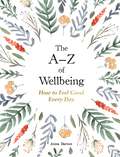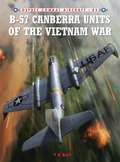- Table View
- List View
Autism Spectrum Disorders Through the Life Span
by Digby TantamThis book contains the latest research on assessment, diagnosis, treatment, intervention and support of individuals with ASD, and examines their implications at various stages of life. A wide range of neurological, genetic, psychological, developmental, social, and emotional issues are covered.
The Autism Spectrum, Sexuality and the Law: What every parent and professional needs to know
by Nick Dubin Isabelle Henault Dr Anthony AttwoodThis ground-breaking book explores the problems that can arise surrounding the autism spectrum (ASD), sexuality and the law. Covering everything from how the ASD profile can affect sexual development to information about current laws, it is essential reading for parents of children with ASD, and mental health and legal professionals.
Automated Machine Learning for Business
by Kai R. Larsen Daniel S. BeckerTeaches the machine learning process for business students and professionals using automated machine learning, a new development in data science that requires only a few weeks to learn instead of years of training Though the concept of computers learning to solve a problem may still conjure thoughts of futuristic artificial intelligence, the reality is that machine learning algorithms now exist within most major software, including Websites and even word processors. These algorithms are transforming society in the most radical way since the Industrial Revolution, primarily through automating tasks such as deciding which users to advertise to, which machines are likely to break down, and which stock to buy and sell. While this work no longer always requires advanced technical expertise, it is crucial that practitioners and students alike understand the world of machine learning. In this book, Kai R. Larsen and Daniel S. Becker teach the machine learning process using a new development in data science: automated machine learning (AutoML). AutoML, when implemented properly, makes machine learning accessible by removing the need for years of experience in the most arcane aspects of data science, such as math, statistics, and computer science. Larsen and Becker demonstrate how anyone trained in the use of AutoML can use it to test their ideas and support the quality of those ideas during presentations to management and stakeholder groups. Because the requisite investment is a few weeks rather than a few years of training, these tools will likely become a core component of undergraduate and graduate programs alike. With first-hand examples from the industry-leading DataRobot platform, Automated Machine Learning for Business provides a clear overview of the process and engages with essential tools for the future of data science.
Automated Machine Learning for Business
by Kai R. Larsen Daniel S. BeckerTeaches the machine learning process for business students and professionals using automated machine learning, a new development in data science that requires only a few weeks to learn instead of years of training Though the concept of computers learning to solve a problem may still conjure thoughts of futuristic artificial intelligence, the reality is that machine learning algorithms now exist within most major software, including Websites and even word processors. These algorithms are transforming society in the most radical way since the Industrial Revolution, primarily through automating tasks such as deciding which users to advertise to, which machines are likely to break down, and which stock to buy and sell. While this work no longer always requires advanced technical expertise, it is crucial that practitioners and students alike understand the world of machine learning. In this book, Kai R. Larsen and Daniel S. Becker teach the machine learning process using a new development in data science: automated machine learning (AutoML). AutoML, when implemented properly, makes machine learning accessible by removing the need for years of experience in the most arcane aspects of data science, such as math, statistics, and computer science. Larsen and Becker demonstrate how anyone trained in the use of AutoML can use it to test their ideas and support the quality of those ideas during presentations to management and stakeholder groups. Because the requisite investment is a few weeks rather than a few years of training, these tools will likely become a core component of undergraduate and graduate programs alike. With first-hand examples from the industry-leading DataRobot platform, Automated Machine Learning for Business provides a clear overview of the process and engages with essential tools for the future of data science.
Autonomous Safety Control of Flight Vehicles
by Xiang Yu Lei Guo Youmin Zhang Jin JiangAerospace vehicles are by their very nature a crucial environment for safety-critical systems. By virtue of an effective safety control system, the aerospace vehicle can maintain high performance despite the risk of component malfunction and multiple disturbances, thereby enhancing aircraft safety and the probability of success for a mission. Autonomous Safety Control of Flight Vehicles presents a systematic methodology for improving the safety of aerospace vehicles in the face of the following occurrences: a loss of control effectiveness of actuators and control surface impairments; the disturbance of observer-based control against multiple disturbances; actuator faults and model uncertainties in hypersonic gliding vehicles; and faults arising from actuator faults and sensor faults. Several fundamental issues related to safety are explicitly analyzed according to aerospace engineering system characteristics; while focusing on these safety issues, the safety control design problems of aircraft are studied and elaborated on in detail using systematic design methods. The research results illustrate the superiority of the safety control approaches put forward. The expected reader group for this book includes undergraduate and graduate students but also industry practitioners and researchers. About the Authors: Xiang Yu is a Professor with the School of Automation Science and Electrical Engineering, Beihang University, Beijing, China. His research interests include safety control of aerospace engineering systems, guidance, navigation, and control of unmanned aerial vehicles. Lei Guo, appointed as "Chang Jiang Scholar Chair Professor", is a Professor with the School of Automation Science and Electrical Engineering, Beihang University, Beijing, China. His research interests include anti-disturbance control and filtering, stochastic control, and fault detection with their applications to aerospace systems. Youmin Zhang is a Professor in the Department of Mechanical, Industrial and Aerospace Engineering, Concordia University, Montreal, Québec, Canada. His research interests include fault diagnosis and fault-tolerant control, and cooperative guidance, navigation, and control (GNC) of unmanned aerial/space/ground/surface vehicles. Jin Jiang is a Professor in the Department of Electrical & Computer Engineering, Western University, London, Ontario, Canada. His research interests include fault-tolerant control of safety-critical systems, advanced control of power plants containing non-traditional energy resources, and instrumentation and control for nuclear power plants.
Autonomous Safety Control of Flight Vehicles
by Xiang Yu Lei Guo Youmin Zhang Jin JiangAerospace vehicles are by their very nature a crucial environment for safety-critical systems. By virtue of an effective safety control system, the aerospace vehicle can maintain high performance despite the risk of component malfunction and multiple disturbances, thereby enhancing aircraft safety and the probability of success for a mission. Autonomous Safety Control of Flight Vehicles presents a systematic methodology for improving the safety of aerospace vehicles in the face of the following occurrences: a loss of control effectiveness of actuators and control surface impairments; the disturbance of observer-based control against multiple disturbances; actuator faults and model uncertainties in hypersonic gliding vehicles; and faults arising from actuator faults and sensor faults. Several fundamental issues related to safety are explicitly analyzed according to aerospace engineering system characteristics; while focusing on these safety issues, the safety control design problems of aircraft are studied and elaborated on in detail using systematic design methods. The research results illustrate the superiority of the safety control approaches put forward. The expected reader group for this book includes undergraduate and graduate students but also industry practitioners and researchers. About the Authors: Xiang Yu is a Professor with the School of Automation Science and Electrical Engineering, Beihang University, Beijing, China. His research interests include safety control of aerospace engineering systems, guidance, navigation, and control of unmanned aerial vehicles. Lei Guo, appointed as "Chang Jiang Scholar Chair Professor", is a Professor with the School of Automation Science and Electrical Engineering, Beihang University, Beijing, China. His research interests include anti-disturbance control and filtering, stochastic control, and fault detection with their applications to aerospace systems. Youmin Zhang is a Professor in the Department of Mechanical, Industrial and Aerospace Engineering, Concordia University, Montreal, Québec, Canada. His research interests include fault diagnosis and fault-tolerant control, and cooperative guidance, navigation, and control (GNC) of unmanned aerial/space/ground/surface vehicles. Jin Jiang is a Professor in the Department of Electrical & Computer Engineering, Western University, London, Ontario, Canada. His research interests include fault-tolerant control of safety-critical systems, advanced control of power plants containing non-traditional energy resources, and instrumentation and control for nuclear power plants.
Autonomy, Authority and Moral Responsibility (Law and Philosophy Library #33)
by T. MayQuestions about the relationship between autonomy and authority are raised in nearly every area of moral philosophy. Although the most ob vious of these is political philosophy (especially the philosophy of law), the issues surrounding this relationship are by no means confined to this area. Indeed, as we shall see as this work progresses, the issues raised are central to moral psychology, religion, professional ethics, medical ethics, and the nature of moral systems generally. Although the title of this work is Autonomy. Authority and Moral Responsibility. we shall be concerned with the more general question about the relationship between autonomy (or self-direction) and exter nal influences, which I take to be any guide to behavior whose presence, content or substance is dependent upon something beyond the control of the agent. Something is beyond the control of the agent if the agent cannot determine whether or not it is present, what its content consists of, or whether or not (or in what way) it influences her. These "external" influences may include (but are not necessarily limited to) religious con victions (which guide behavior according to a doctrine whose content is established independently of the agent); moral obligations (which re quire action in accordance with some moral theory); and desires for ob jects or states of affairs whose presence (or absence) is beyond the con trol of the agent. Of course, external influences may also include the requirements of authority or law.
Autonomy, Freedom and Rights: A Critique of Liberal Subjectivity (Law and Philosophy Library #65)
by Emilio SantoroFor the author freedom is not a fixed measure. It is not the container of powers and rights defining an individual's role and identity. It is rather the outcome of a process whereby individuals continuously re-define the shape of their individuality. Freedom is everything that each of us manages to be in his or her active and uncertain opposition to external 'pressures'.
Autonomy in the Law (Ius Gentium: Comparative Perspectives on Law and Justice #1)
by Mortimer SellersBy juxtaposing European and American concepts of autonomy in the law as they are applied to families, capital punishment and criminal trials, authors reveal the common values that justify all legal systems. This book sheds new light on the fundamental purpose of law by examining how European and American lawyers, judges, and citizens actually apply and should apply legal autonomy to litigation, legislation, and the law itself.
Autopoiesis and Cognition: The Realization of the Living (Boston Studies in the Philosophy and History of Science #42)
by H.R. Maturana F.J. VarelaThis is a bold, brilliant, provocative and puzzling work. It demands a radical shift in standpoint, an almost paradoxical posture in which living systems are described in terms of what lies outside the domain of descriptions. Professor Humberto Maturana, with his colleague Francisco Varela, have undertaken the construction of a systematic theoretical biology which attempts to define living systems not as they are objects of observation and description, nor even as in teracting systems, but as self-contained unities whose only reference is to them selves. Thus, the standpoint of description of such unities from the 'outside', i. e. , by an observer, already seems to violate the fundamental requirement which Maturana and Varela posit for the characterization of such system- namely, that they are autonomous, self-referring and self-constructing closed systems - in short, autopoietic systems in their terms. Yet, on the basis of such a conceptual method, and such a theory of living systems, Maturana goes on to define cognition as a biological phenomenon; as, in effect, the very nature of all living systems. And on this basis, to generate the very domains of interac tion among such systems which constitute language, description and thinking.
The Average Consumer in Confusion-based Disputes in European Trademark Law and Similar Fictions
by Rasmus Dalgaard LaustsenThis book contends that, with regard to the likelihood of confusion standard, European trademark law applies the average consumer incoherently and inconsistently. To test this proposal, it presents an analysis of the horizontal and vertical level of harmonization of the average consumer. The horizontal part focuses on similar fictions in areas of law adjacent to European trademark law (and in economics), and the average consumer in unfair competition law. The vertical part focuses on European trademark law, represented mainly by EU trademark law, and the trademark laws of the UK, Sweden, Denmark and Norway. The book provides readers with a better understanding of key aspects of European trademark law (the average consumer applied as part of the likelihood of confusion standard) and combines relevant law and practices with theoretical content and other related areas of law (and economics). Accordingly, it is an asset for policymakers and practitioners, as well as general readers with an interest in intellectual property law and theory.
Avian Architecture: How Birds Design, Engineer, and Build
by Peter GoodfellowBirds are the most consistently inventive builders, and their nests set the bar for functional design in nature. Avian Architecture describes how birds design, engineer, and build their nests, deconstructing all types of nests found around the world using architectural blueprints and detailed descriptions of the construction processes and engineering techniques birds use. This spectacularly illustrated book features 300 full-color images and more than 35 case studies that profile key species worldwide. Each chapter covers a different type of nest, from tunnel nests and mound nests to floating nests, hanging nests, woven nests, and even multiple-nest avian cities. Other kinds of avian construction--such as bowers and harvest wells--are also featured. Avian Architecture includes intricate step-by-step sequences, visual spreads on nest-building materials and methods, and insightful commentary by a leading expert. Illustrates how birds around the world design, engineer, and build their nests Features architectural blueprints, step-by-step sequences, visual spreads on nest-building materials and methods, and expert commentary Includes 300 full-color images Covers more than 100 bird species worldwide
Avian Architecture: How Birds Design, Engineer, and Build
by Peter GoodfellowBirds are the most consistently inventive builders, and their nests set the bar for functional design in nature. Avian Architecture describes how birds design, engineer, and build their nests, deconstructing all types of nests found around the world using architectural blueprints and detailed descriptions of the construction processes and engineering techniques birds use. This spectacularly illustrated book features 300 full-color images and more than 35 case studies that profile key species worldwide. Each chapter covers a different type of nest, from tunnel nests and mound nests to floating nests, hanging nests, woven nests, and even multiple-nest avian cities. Other kinds of avian construction--such as bowers and harvest wells--are also featured. Avian Architecture includes intricate step-by-step sequences, visual spreads on nest-building materials and methods, and insightful commentary by a leading expert. Illustrates how birds around the world design, engineer, and build their nests Features architectural blueprints, step-by-step sequences, visual spreads on nest-building materials and methods, and expert commentary Includes 300 full-color images Covers more than 100 bird species worldwide
Avian Architecture Revised and Expanded Edition: How Birds Design, Engineer, and Build
by Peter GoodfellowThe essential illustrated guide to how birds design and build their nests—now fully revised and expandedBirds are the most consistently inventive builders, and their nests set the bar for functional design in nature. Describing how birds design, engineer, and build their nests, Avian Architecture deconstructs all types of nests found around the world using architectural blueprints and detailed descriptions of the construction processes and engineering techniques birds use.This spectacularly illustrated book features more than 300 full-color images and more than 40 case studies that profile key species worldwide. Each chapter covers a different type of nest, from tunnel nests and mound nests to floating nests, hanging nests, woven nests, and even multiple-nest avian cities. Other kinds of avian construction—such as bowers and food stores—are also featured.Now with more case studies and an updated foreword, this revised and expanded edition includes intricate step-by-step sequences, visual spreads on nest-building materials and methods, and insightful commentary by a leading expert.Illustrates how birds around the world design, engineer, and build their nestsFeatures architectural blueprints, step-by-step sequences, visual spreads on nest-building materials and methods, and expert commentaryIncludes more than 300 full-color imagesCovers more than 100 bird species worldwide
Awkward.: What to Do When Life Makes You Cringe—A Survival Guide
by Sam ScholfieldNo One Is Safe from Awkward!Ending a first date that falls flat. Drunk-texting your boss. Walking in when your roommate is getting it on. Running into the person you just dumped . . . in the grocery store, an hour after it went down.Awkward bombs can drop anytime, anywhere, and with anyone—people you don’t know, people you see occasionally, and people you see every day. They can sneak up on you and explode in the most unexpected of places, so they’re basically impossible to avoid.The vast majority of us don’t have the wherewithal to gracefully handle the truly and totally awkward as it unfolds. We only realize what we should have said after the fact—when the damage has already been done and we’re a hot mess of embarrassment, red ears, and nervous sweat stains. But author Sam Scholfield has survived more than two decades of embarrassing encounters—and now, in an act of extreme generosity, has set down a wealth of witty comebacks, surefire distraction techniques, and suave evasion strategies so that future generations may take heed and dodge the Awkward Monster before it strikes!So how do you avoid the epic cluster of drama that can result when awkward situations are handled badly? You read this book.
Axiological Pluralism: Jurisdiction, Law-Making and Pluralisms (Ius Gentium: Comparative Perspectives on Law and Justice #92)
by Lucia Busatta Carlo CasonatoThis book analyses the features and functionality of the relationship between the law, individual or collective values and medical-scientific evidence when they have to be interpreted by judges, courts and para-jurisdictional bodies. The various degrees to which scientific data and moral values have been integrated into the legal discourse reveal the need for a systematic review of the options and solutions that judges have elaborated on. In turn, the book presents a systematic approach, based on a proposed pattern for classifying these various degrees, together with an in-depth analysis of the multi-layered role of jurisdictions and the means available to them for properly handling new legal demands arising in plural societies.The book outlines a model that makes it possible to focus on and address these issues in a sustainable manner, that is, to respond to individual requests and technological advances in the field of biolaw by consistently and effectively applying suitable legal instruments and jurisdictional interpretation.
Axioms and Principles of Plant Construction: Proceedings of a symposium held at the International Botanical Congress, Sydney, Australia, August 1981
by R. SattlerThis volume presents the proceedings of a symposium which I organised for the Developmental Section of the Xlllth International Botanical Congress at Sydney, Australia on August 26, 1981. The paper by Professor T. Sachs, which was received too late for inclusion into the symposium at Sydney, was added to these proceedings because of its direct relevancy and importance. The aim of the symposium was to state in an explicit and comprehensive fashion the most basic axioms and principles of plant morphology and morphogenesis. An awareness of these axioms and principles is of paramount importance since they form. the foundations as well as the goal of structural developmental botany. Both teaching and research are predicated on them. The Introduction by the editor briefly examines the meaning of the concepts "axiom", "principle", and "plant construction". The comprehensive paper by Dr. G. Cusset, a unique historical overview, explicates 37 principles of 5 major conceptual systems and many subsystems. The extensive analysis includes a genealogy of ideas and ways of thinking of major authors ranging from philosophers and naturalists of antiquity to recent investigators of plant form and structure. The bibliography of Dr. Cusset I s paper comprises ca. 700 references. The contribution by Professor H. Mohr focusses on modern principles of morphogenesis and provides a penetrating analysis of scientific explanation in developmental biology. The universal principles (laws) described in this paper apply to all living systems, whereas the more specific principles are limited to plants or only higher plants. Professor T.
Ayurvedic Inheritance: A Reader's Companion
by M S ValiathanThis book is a companion to Āyurvedic studies. It discusses the history and evolution of Ayurveda, its philosophy, and its practical uses in everyday life—from medicine to mental wellbeing. It harks back to the traditional Indian concept of four aspects of lifelong learning. These were instruction by the teacher, individual effort, learning from companions and lastly, wisdom gathered over a lifetime. Print edition not for sale in South Asia (India, Sri Lanka, Nepal, Bangladesh, Pakistan and Bhutan)
Ayurvedic Inheritance: A Reader's Companion
by M S ValiathanThis book is a companion to Āyurvedic studies. It discusses the history and evolution of Ayurveda, its philosophy, and its practical uses in everyday life—from medicine to mental wellbeing. It harks back to the traditional Indian concept of four aspects of lifelong learning. These were instruction by the teacher, individual effort, learning from companions and lastly, wisdom gathered over a lifetime. Print edition not for sale in South Asia (India, Sri Lanka, Nepal, Bangladesh, Pakistan and Bhutan)
The A–Z of Death and Dying: Social, Medical, and Cultural Aspects
by Michael BrennanThis engaging and informative resource provides readers with an understanding of the social, cultural, and historical influences that shape our encounters with death, dying, and bereavement—a universal experience across humanity.Written in an engaging and accessible style by leading international scholars and practitioners from within the field of death and bereavement studies, this book will have broad appeal, providing in a single volume insights from some of the key thinkers within the interdisciplinary field of death, dying, and bereavement. Its approximately 200 entries will serve as useful starting points for those new to the topic and will be informative to those already acquainted with some of the core concepts and ideas within this burgeoning field of inquiry. This encyclopedia will serve as an essential resource for high school and undergraduate students, those engaged in independent research, and professionals whose work involves caring for the dead, dying, and bereaved. It will also be of great interest to general readers intrigued by the social, medical, and cultural dimensions to human mortality. Underscored by the inescapable biological certainties that affect us all, The A–Z of Death and Dying offers a highly relevant examination of the social and historical variation in the rituals, practices, and beliefs surrounding the end of life.
The A–Z of Death and Dying: Social, Medical, and Cultural Aspects
by Michael John BrennanThis engaging and informative resource provides readers with an understanding of the social, cultural, and historical influences that shape our encounters with death, dying, and bereavement—a universal experience across humanity.Written in an engaging and accessible style by leading international scholars and practitioners from within the field of death and bereavement studies, this book will have broad appeal, providing in a single volume insights from some of the key thinkers within the interdisciplinary field of death, dying, and bereavement. Its approximately 200 entries will serve as useful starting points for those new to the topic and will be informative to those already acquainted with some of the core concepts and ideas within this burgeoning field of inquiry. This encyclopedia will serve as an essential resource for high school and undergraduate students, those engaged in independent research, and professionals whose work involves caring for the dead, dying, and bereaved. It will also be of great interest to general readers intrigued by the social, medical, and cultural dimensions to human mortality. Underscored by the inescapable biological certainties that affect us all, The A–Z of Death and Dying offers a highly relevant examination of the social and historical variation in the rituals, practices, and beliefs surrounding the end of life.
A–Z of Irish Names for Children and Their Meanings: Finding the Perfect Irish Name for Your New Baby
by Dr Diarmaid O MuiritheIncluding over four hundred beautiful, original and unusual Irish names, Diarmaid Ó Muirithe’s brilliant reference book provides the origin, historical and cultural background of practically every Irish name you have ever come across and many you have not!Peppered with witty snippets of information in Diarmaid Ó Muirithe’s unique style, The A–Z of Irish Names for Children is the perfect guide to naming your child.In Ireland we have a wonderful selection of names to choose from. We have our own Irish versions of biblical names, the names of the Evangelists and of continental saints who have taken our fancy at various stages in our history. The Vikings left us some of their personal names, which either in their Irish or their Anglicised forms have proved to be as hardy a growth as those names given to us by the Anglo-Normans. Lots of them are included in this charming and informative book. And, of course, we have the great repository of the old Irish tradition from which to choose our children’s names.From Aaron to Úna, Diarmaid Ó Muirithe provides a gloss on more than four hundred Irish forenames in his inimitable style that mixes scholarship and wit with quirky and entertaining facts and stories. Thus, we learn that the name Art has nothing to do with Arthur; that Brendan is originally of Welsh origin and came to Ireland in a Latinised form; that Cathal is usually translated as Charles, although there is no historical connection between the two; and much more. As with all Diarmaid Ó Muirithe’s work, The A–Z of Irish Names for Children is a model of scholarship lightly worn, informed by a sense of curiosity and fun. It’s the perfect book from which to choose your child’s name or find out more about your own Irish name and roots.
The A–Z of Positivity: How to Feel Happier Every Day
by Anna BarnesDive into this beautiful ABC of tips to discover the art of positive thinkingA is for affirmation. B is for believe. C is for compliment.There's magic in making the best out of a bad situation, no matter what life throws at you. Luckily, there are plenty of little things you can do to brighten your outlook and bring a ray of sunshine to every moment. Whether you choose to try laughter therapy, take a digital detox or tap into the power of nature, this charming A-Z guide will help your inner optimist thrive, and show you how to bring more positivity into every day.Within these pages, you will find: An A-Z of simple tips to help you boost positive thinking A raft of calming affirmations and wise words to inspire you Activity ideas and fill-in sections to start you on your journey With ideas to nourish your mind, body and spirit, this little book will help you achieve a more balanced attitude to life and be positively you.
The A–Z of Wellbeing: How to Feel Good Every Day
by Anna BarnesDive into this beautiful ABC of tips to discover the art of living well every dayA is for attitude. B is for balance. C is for connection.The things that add up to a happier life don't have to be complicated. Whether you choose to dance and sing, give yoga a go or tap into the power of quietude and kindness, this charming A-Z guide will help you find your perfect path towards a greater sense of well-being.Within these pages, you will find: An A-Z of simple tips to help you boost your well-being A raft of calming affirmations and wise words to inspire you Activity ideas and fill-in sections to start you on your journey Inspiration for bringing more happiness into every day With ideas to nourish your mind, body and spirit, let this little book help you work your way to a wonderful sense of well-being.
B-57 Canberra Units of the Vietnam War (Combat Aircraft)
by Jim Laurier T. E. BellThe B-57 Canberra was the first jet-powered American attack aircraft committed to the Vietnam War. Involved in day-to-day interdiction missions as well as in classified "black†? missions and a starring role in Operation Rolling Thunder; the B-57 evolved to become one of the most valuable weapons in the USAF inventory. The B-57E was involved in the Patricia Lynn missions, parts of which remain classified. This book also fully documents the role of the Australian Canberra B-20 in working alongside the B-57. Featuring scores of previously unpublished photographs; the story of the B-57 is the story of the Vietnam War.


